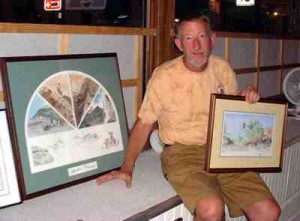Brief by Central Staff
Regional News – October 2005 – Colorado Central Magazine
Katrina Assistance
For the fortnight before our deadline, Hurricane Katrina and its aftermath dominated the national news. On the local front, Central Colorado has been generous, with a few refugees moving here — our high and dry climate, not to mention autumn coolness, must be quite a change from the low, humid, and hot Gulf Coast.

Two families from the stricken area have relatives in Buena Vista, and have moved there. They don’t have much more than their clothes and vehicles; the Chamber of Commerce (719-395-6612) is handling donations.
Western State College in Gunnison offered immediate admission to displaced college students, along with a temporary fee waiver, and one, an art major at Tulane University in New Orleans, has already enrolled.
A Salida couple offered a house rent-free for a refugee family, and throughout Central Colorado, there were fund drives, collections of clothing and household goods, and money-raising events.
The Blue Mesa Blues
Due to a healthy winter snowpack, experts predicted that Blue Mesa Reservoir would be full this summer. But it’s not. In late July, the reservoir was about 200,000 acre feet short of its capacity of 830,000 acre feet of water.
Theories abound as to why ample snow and rain failed to fill Blue Mesa, but most experts assume it’s because a decade of drought has left the ground thirsty. So dry and cracked subsurface soil apparently lapped up last winter’s snowpack – even though it was132 percent of average.
The only good news is that officials didn’t have to worry about what to do after Blue Mesa filled – even though it had been predicted that there would not be room in the reservoir for this year’s snowmelt.
Variable Interest
School board elections used to be held in May, along with other special-district elections (i.e., hospital districts, fire districts, sanitation districts, etc.). Some legislators believed that the typical low turn-out meant that the spring board elections could thus be dominated easily by the teachers’ unions and their allies, and so the state moved the school elections to November, when more people typically vote.
However, there have to be competing candidates for an election to be held. If there’s only one running for each open seat, the district can cancel the election, and that’s what happened in Buena Vista, where four candidates filed for four seats.
It’s a different story in Cotopaxi, though. Charlie Green of Texas Creek, who sits on that school board, reports that three of the five board members are term-limited this year, and voters have twice turned down measures to repeal term limits.
“This has created problems with getting enough candidates to fill the seats in some past elections,” he said. But not this year, as there are six candidates for three seats.
“The school administration was hoping for three candidates for three seats and thus be able to save some money by canceling the election. No such luck; we’re going to have an election. The messy price of democracy.”
Open and Shut cases
Lake County is trying to keep one road open and another one closed. On Aug. 19, the county commissioners confiscated a gate that had blocked the old stagecoach road leading to part of the Pan-Ark subdivision. The land beside the road is private, but the county had several court decisions supporting its position that the road is public.
Another route in the same general area, between the forebay and the Pan-Ark subdivision, has been used by vehicles for several years despite Forest Service efforts to keep it posted and closed. This summer, fences were put up — and then torn down. Now there are boulders blocking one end. “It was never a road. It’s an illegal route,” explained Bill Mulholland of the U.S. Forest Service.
Meanwhile, Gunnison County is trying to find a way to re-open the Fossil Ridge Trail, a back-country route long popular with hikers and cyclists. Tom Chapman owns a 40-acre parcel along the trail about a dozen miles northeast of town, and in mid-August, he put up closure gates and no-trespassing signs.
Chapman has made a career out of buying inholdings (properties surrounded by public lands), and then selling or trading them for a substantial profit. “This is what he does,” Gunnison County Commissioner Jim Starr said. “He gets these parcels that are critical to the public and then holds them as ranson to the Forst Service.”
Lost and Found
Big-game hunters get lost every fall. But it was another kind of hunter who was lost in Custer County. Roseanne Hausman, a 57-year-old Colorado Springs woman, was out hunting mushrooms near Greenhorn Road when she became separated from her family and friends. They reported her missing on Sept. 3.
She was found three days later by a search team. She had abrasions and an upset stomach, but no life-threatening injuries. “We were quite worried,” Custer County Sheriff Fred Jobe said, as the woman was wearing only a tank top and jeans where night temperatures were dipping into the 30s.
Dead Baby Found in Outhouse
A dead newborn was found in an outhouse at the Lakeview Campground in Taylor Park, reported the August 18 Gunnison Country Times.
After the Gunnison County Emergency Medical Services transported a woman to the Gunnison Valley Hospital on August 7, it was determined that she had recently given birth. So authorities were dispatched to look for an infant. At first they found nothing. But on August 9, searchers located a dead baby in the tank of a privy. At that point, it was unclear whether the infant was dead or alive when left in the outhouse, and an investigation ensued.
Depending upon the results, charges could range from homicide, to manslaughter, to concealing a death, a misdemeanor. The woman is thirty-five years old and from “out of town.”
No more Leadville natives?
To be a native of a place, you have to be born there; that’s inherent in the word, which comes from nativus, Latin for “to be born.” (This should mean that there’s no such thing as a “native tongue,” since none of us is born knowing any language).
At any rate, Leadville natives will be in short supply in the future because the board of St. Vincent’s Hospital there voted on Aug. 25 to suspend obstetrical services at the hospital. That came about because the hospital needs two certified obstetricians in practice, and only one was available.
Planned deliveries will be made across the Continental Divide in either Summit or Eagle County until the hospital can resume obstetrical services. Given the vagaries of mountain transportation in the winter, though, it’s possible there will be some emergency Leadville births.
Honors
Nancy Oswald of Cotopaxi received the 2005 Willa Award for her juvenile novel, Nothing Here But Stones, about an 11-year-old girl and her family who joined the 1882 Jewish colony south of Cotopaxi. The award, presented by Women Writing the West, is named for Willa Cather, whose stories were set in Nebraska and the southwest. Based on her research for the novel, Oswald wrote a short history of the Cotopaxi colony, which appeared in the February edition of Colorado Central.
Melanie Milam Roth of Nathrop was named Outstanding Tourism Volunteer by the Governor’s Conference on Tourism in September. Tourism is basically a by-product of her work, though; she focuses on historic preservation. Most recently, she has been raising money to rebuild the St. Elmo town hall after it burned down in 2003. She has also chaired Buena Vista Heritage for several years.
Good News for Educators
Silverheels Middle School in Park County was identified as a Distinguished School by the Colorado Department of Education due to a 20-percent point increase in math scores for students eligible for free or reduced lunches. Students who qualify for those lunch designations are considered at-risk, and thus receive extra help with reading, writing, and math – which apparently has paid off. According to the Fairplay Flume, the CDE presented Silverheels administrators with a $5,000 award on August 19.
More Good News
The National Geographic Society awarded Mark Stiger, the archeologist at the Mountaineer archeological site on W Mountain, a $20,000 grant to support his project.
With the aide of volunteers and his student/assistants from Western State College, Stiger has been excavating a Folsom settlement near Gunnison, and also working on an “environmental reconstruction” to discover what kinds of plants and animals were there during the Folsom period.
Samples of charcoal and other material — sent to the Santa Fe Museum in New Mexico for analysis – should determine what kinds of trees the Folsom people at that site used for firewood and dwellings, and also discover seeds that reveal more about their environment. The Mountaineer site also included clay brought in from somewhere else.
In the early 1990s, Stiger started excavating the Tenderfoot site, at the base of W Mountain, where he also did an environmental reconstruction. According to a recent Gunnison Country Times feature about Western State College programs, the Tenderfoot reconstruction revealed that pinon trees were present up to 3,000 years ago – even though they aren’t found in the Gunnison Valley today.
Stiger’s findings at the Tenderfoot site, and information from other archeological sites in Colorado, are the topic of his book Hunter-Gatherer Archaeology of the Colorado High Country published by the University of Colorado Press.
Observations
“Instead of serving as a major commercial and entrepreneurial center, New Orleans’ dominant industry lies not in creating its future but selling its past, much of which now sits underwater. Tourism defines contemporary New Orleans’ economy more than its still-large port, or its remaining industry, or its energy pro duction. Although there is nothing wrong, per se, in being a tourist town, it is not an industry that attracts high-wage jobs; and tends to create a highly bifurcated social structure. This can be seen in New Orleans’ perennially high rates of underemployment, crime, and poverty.”
— Joel Kotkin in the Wall Street Journal, p. A10, Sept. 1, 2005
“I’m pretty much a novice.”
Jeff Wise of Gunnison, whose kayak outing at the Gunnison Whitewater Park ended in his near-drowning before he was rescued by Scott Gates and Mike Sanders of Crested Butte.
On a Denver Channel 7 piece about how Hurricane Katrina refugees are being housed in dormitories at the former Lowry Air Force Base in Denver, Gov. Bill Owens said “Colorado will be here for these people as long as they need help.”
So, where will Colorado be after that? Are we moving to even higher ground?
“In the final analysis, it may be easier for the Front Range to pump water from Lake Michigan than Green Mountain [a reservoir between Silverthorne and Kremmling on the Western Slope].”
Eric Kuhn, Colorado River Conservation District, Denver Post, p. 3B, Sept. 8, 2005.
“You deal with this stuff long enough, no matter how good of a job you do, something can always go wrong.”
Knox Williams, director of the Colorado Avalanche Center, speaking of a rare in-bounds avalanche that killed a skier at Arapahoe Basin, Denver Post, p. 8C, Sept. 11, 2005.


